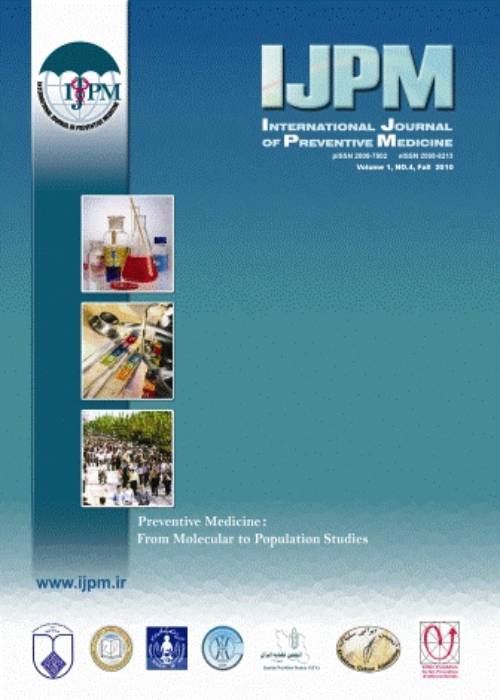فهرست مطالب

International Journal of Preventive Medicine
Volume:14 Issue: 10, Oct 2023
- تاریخ انتشار: 1402/09/11
- تعداد عناوین: 4
-
-
Page 1Background
It is well established that unrefined sugarcane products have antioxidant activity due to phytochemicals, polyphenols, and total antioxidant capacity, which may decrease inflammation and oxidative stress. Therefore, we conducted a systematic review to evaluate the association of unrefined sugar consumption with inflammatory biomarkers.
MethodsGoogle Scholar, ScienceDirect, Scopus, Cochrane Library, and ProQuest databases were searched up to December 2021 for studies that report the effect of unrefined sugar on inflammation according to inflammatory cytokines, chemokine, and adhesion molecules as outcome measures.
ResultsThirty‑six studies were evaluated. Across all research, five studies (two in vitro and three animal studies) reported the effect of unrefined sugar on levels of cytokines, including IL‑6, TNF‑α, IL‑10, IL‑1β, and IFN‑γ. Additionally, the quality of the studies was assessed for risk of bias.
Conclusionsit is possible to affirm that unrefined sugarcane products, including jaggery, may have a protective effect on inflammation via regulating some of the inflammatory pathways and a favorable impact on cytokines secretion according to the results of in vitro and animal model studies. However, since the findings are still insufficient, more scientific research, especially well‑designed human trials, is highly recommended to conclude the outcomes confidently. Human data may encourage industries and the public to replace purified sugar with unrefined sugarcane in sugar‑based food and for further health‑care policy decisions.
Keywords: Brown sugar, dietary sugar, inflammation, sugarcane, systematic review, unrefined sugar -
Page 2Background
Since the establishment of the International Health Promotion Hospitals (HPH) in 2006, standards have been designed to evaluate this network. Based on the request of the General Assembly of HPH, the new standards have been revised in 2020 to be in harmony with the new global strategy of HPH for the years 2021–2025. The present study was conducted to translate the original version of the self‑evaluation form of HPH and to determine its validity and reliability in Iranian society.
MethodsThe standard process of forward and backward translation was followed after that to determine the face validity of the Persian version of HPH standards, fifteen experts from ten hospitals in five major cities in Iran (Tehran, Mashhad, Isfahan, Shiraz and Hamadan) gave their opinions about 86 standard statements based on a five‑point Likert scale, and the impact score was calculated. For determining content validity, both the content validity ratio (CVR) and content validity index (CVI) were used.
ResultsAll 86 standard statements of the five main standards had an impact score higher than 1.5. Also, regarding CVR, all 86 standard statements had a score higher than 0.49 (the minimum plausible score based on Lawshe’s table). Finally, after calculating the CVI, all the standard statements had a CVI higher than 0.8, which indicated a very good content validity index for all the items.
ConclusionsAccording to the results of this study, the Persian form of the 2020 HPH standards is valid enough to be used in Iranian hospitals and health services.
Keywords: Health‑promoting hospitals, Iran, standards, validity -
Page 3Background
The stress of surgery itself results in metabolic disturbance. Few studies have mentioned how to manage the metabolic profile of diabetic patients after discharge from the hospital. The present study aimed to determine the effect of home care on metabolic profile and blood pressure in type 2 diabetic patients who underwent general surgeries.
MethodsSeventy type 2 diabetic patients who were undergoing surgery were assigned to the intervention and control groups via blocking order. The intervention group received a 3‑month home care with an interprofessional team approach. The levels of fasting blood glucose, glycosylated hemoglobin (HbA1c), total cholesterol, triglycerides, high‑density lipoprotein cholesterol (HDL‑c), low‑density lipoprotein cholesterols, systolic blood pressure, and diastolic blood pressure were measured before and three months after the intervention in both groups. In the control group, only routine care was performed in the postsurgery period. Data were entered in SPSS software version 23 and were analyzed.
ResultsThere were no significant differences between the intervention and control groups for background characteristics. Systolic blood pressure (P < .001), diastolic blood pressure (P = 0.005), lipid profile (P = 0.001) [except for triglycerides level], fasting blood glucose (P = .001), and HbA1c (P = .003) decreased significantly in the intervention group. After controlling baseline data by applying analysis of covariance, a significant increase in HDL‑c (P = .032) was seen. Also, the difference between the mean percentage of variations in HbA1c levels between intervention and control groups was significant.
ConclusionsOur study showed improvement in HbA1c and HDL‑c levels with home care programs in patients with diabetes who underwent general surgeries. More studies with longer follow‑ups are necessarily addressing the effects of home care on other metabolic parameters in these patients.
Keywords: Blood glucose, blood pressure, diabetes mellitus, home care services, lipid, type 2

